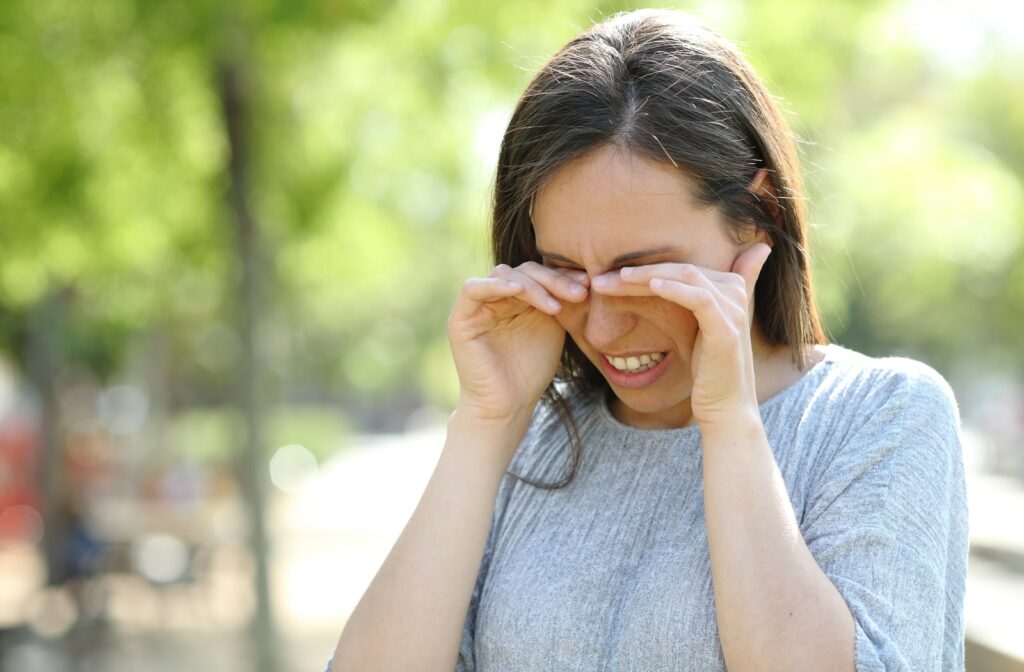There is nothing ordinary about dry eye disease, and you certainly don’t have to live with it. With proper management and therapy, you can find relief from dry eye disease.
The symptoms of dry eye disease can be frustrating and irritating. Apart from redness, blurry vision, and other signs, some individuals may also experience floaters. It turns out dry eye disease does not cause floaters.
Let’s find out more about dry eye disease, what causes floaters, and when to talk to your eye doctor about your concerns, discuss symptoms, and diagnose any eye conditions.
What is Dry Eye Disease?
Dry eye disease, also called ocular surface disease (OSD), is a common condition that affects almost 16 million people in America. The cause of dry eye is not one thing but rather a combination of many different factors.
Some people develop dry eye disease because they have poor tear production, poor quality of tears, or their tears dry up fast. Other causes include:
- Inflammation or infection in the eye, leading to dryness.
- Environmental exposures to wind and air conditioning.
- Auto-immune diseases
- Medications, for example, some chemotherapy drugs.
- Hormonal changes in pregnancy, menopause, or when taking oral contraceptives.
- Wearing contact lenses over the long term.
Symptoms of Dry Eyes
Symptoms of dry eye disease appear when the tear film has evaporated from the eye, causing the layer of tears to become thinner or not exist at all. External factors like wind, air conditioning, heating, blinking less, and prolonged computer use can worsen symptoms.
Dry eye disease presents with the following symptoms:
- Irritation
- Redness or inflammation
- Blurry vision
- Tearing or watery eyes
- Burning or scratchiness
Treatment for dry eye disease involves taking Omega-3 fatty acids (DHA & EPA), wearing sunglasses, prescription eye drops, limiting screen time/taking blink breaks and using artificial tears. For more severe conditions in office procedures, such as, Optilight and/or LipiFlow, are available.
What are Floaters?
Floaters often appear as cloudy or blurry spots in the vision, although they are not actually in the eye. These result from age-related changes in the vitreous gel that fills the center of the eye.
The vitreous becomes less dense and more liquid. Tiny fibers can now float freely and clump together, causing shadows on the retina. These shadows are called floaters.
Floaters can fill your entire vision or create subtle shadows and spots. Either way, when you see floaters, they can be quite annoying.
Floaters do not get better with glasses, and you cannot remove them by rubbing your eyes. They don’t typically cause any harm but can indicate an underlying condition. See your eye doctor if you notice these changes:
- Increase in the number or size of the floaters
- New floaters
- Flashes of light and floaters in the same eye
- See a veil or sheer curtain affecting your vision
- Peripheral vision loss (darkness on the side of the eye)
Causes of Floaters
While dry eye disease occurs due to the quality of tears and lack of tear production, it also shares a common causing factor with floaters—age. Floaters appear as a natural process of aging, meaning from age-related changes in the eye.
Apart from age, you are at increased risk of developing floaters if you:
- Are nearsighted
- Have diabetic retinopathy
- Had cataract surgery
- Had eye trauma or inflammation
Symptoms of Floaters
Floaters are usually dark spots, strands, cobweb-like lines, or shapes. The floaters may come and go, sometimes, you might see more than one at a time, or they can change shape and size.
Floaters move when you move your eyes. Even if you look directly at them, they move away quickly. If you keep your eyes still, they drift out of vision.
Floaters are more pronounced when looking at something bright such as a white wall, white paper, or blue sky.
How To Treat Floaters
If floaters occur as you age, no treatment is necessary. When they affect your vision or interfere with daily life, treatment will depend on the underlying cause.
Vitrectomy is a surgical procedure that drains vitreous fluid with floaters or clumps of tissue. For other causes of floaters, such as inflammation at the back of the eye, bleeding in the eye, eye surgeries, retinal tear, or retinal detachment, treating those will remove the floaters.
A new option for some types of floaters is YAG vitreolysis. This procedure uses a laser to vaporize the floater. Unfortunately, this does not work for all types of floaters.
Invest in Healthy Vision
Dry eyes and floaters are unrelated conditions that both develop with age. There are treatment options and relief for both conditions.
If you notice changes in your vision, dry eye symptoms, new floaters, bright flashes, or dark shadows, don’t delay. Visit Perry & Morgan Eye Care to help diagnose your condition with a comprehensive eye exam. Book your appointment today.



